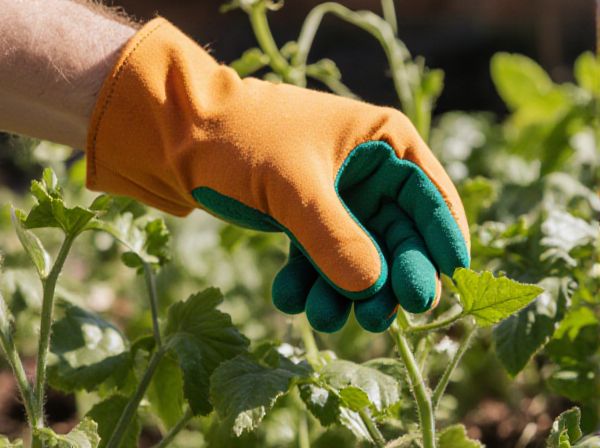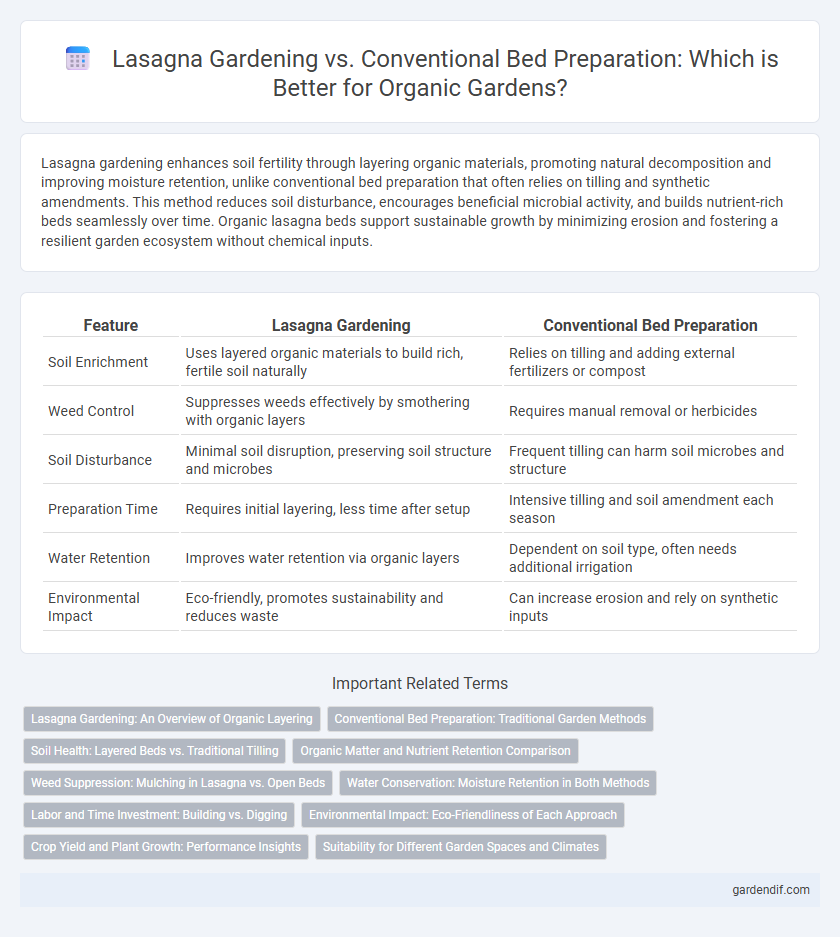
Lasagna gardening vs conventional bed preparation Illustration
Lasagna gardening enhances soil fertility through layering organic materials, promoting natural decomposition and improving moisture retention, unlike conventional bed preparation that often relies on tilling and synthetic amendments. This method reduces soil disturbance, encourages beneficial microbial activity, and builds nutrient-rich beds seamlessly over time. Organic lasagna beds support sustainable growth by minimizing erosion and fostering a resilient garden ecosystem without chemical inputs.
Table of Comparison
| Feature | Lasagna Gardening | Conventional Bed Preparation |
|---|---|---|
| Soil Enrichment | Uses layered organic materials to build rich, fertile soil naturally | Relies on tilling and adding external fertilizers or compost |
| Weed Control | Suppresses weeds effectively by smothering with organic layers | Requires manual removal or herbicides |
| Soil Disturbance | Minimal soil disruption, preserving soil structure and microbes | Frequent tilling can harm soil microbes and structure |
| Preparation Time | Requires initial layering, less time after setup | Intensive tilling and soil amendment each season |
| Water Retention | Improves water retention via organic layers | Dependent on soil type, often needs additional irrigation |
| Environmental Impact | Eco-friendly, promotes sustainability and reduces waste | Can increase erosion and rely on synthetic inputs |
Lasagna Gardening: An Overview of Organic Layering
Lasagna gardening utilizes organic layering by stacking decomposable materials like cardboard, compost, and straw directly onto the soil, creating nutrient-rich beds without tilling. This method promotes soil health through natural decomposition, enhancing moisture retention and microbial activity, unlike conventional bed preparation that often disrupts soil structure. By emulating forest floor processes, lasagna gardening supports sustainable organic growth with minimal soil disturbance.
Conventional Bed Preparation: Traditional Garden Methods
Conventional bed preparation involves tilling the soil to break up compacted layers, allowing better root penetration and aeration for healthy plant growth. Gardeners often incorporate organic matter such as compost or manure into the soil to improve fertility and nutrient availability in traditional beds. This method requires regular maintenance, including weeding and soil amendment, to sustain productivity and maintain optimal growing conditions.
Soil Health: Layered Beds vs. Traditional Tilling
Lasagna gardening enhances soil health by building nutrient-rich, layered beds that improve moisture retention and microbial activity, reducing soil compaction commonly caused by traditional tilling. Traditional bed preparation involves turning over soil, which can disrupt soil structure, decrease beneficial organisms, and increase erosion risk. Layered beds in lasagna gardening promote sustainable soil ecosystems, fostering long-term fertility and plant resilience.
Organic Matter and Nutrient Retention Comparison
Lasagna gardening significantly enhances organic matter content by layering decomposing plant materials, which enriches soil structure and microbial activity more effectively than conventional bed preparation. This method boosts nutrient retention by creating a slow-release composting process that minimizes nutrient leaching and improves soil fertility over time. Conventional bed preparation often relies on tilling, which can disrupt soil organisms and hasten organic matter breakdown, resulting in lower nutrient retention compared to lasagna gardening.
Weed Suppression: Mulching in Lasagna vs. Open Beds
Lasagna gardening excels in weed suppression through thick layers of organic mulch that smother weed seeds and prevent light penetration, significantly reducing weed growth. Conventional bed preparation often relies on bare soil which exposes weed seeds to light, promoting germination and requiring frequent manual weeding or chemical control. The dense, layered mulch in lasagna gardens fosters a weed-free environment while enhancing soil moisture retention and nutrient cycling.
Water Conservation: Moisture Retention in Both Methods
Lasagna gardening significantly enhances water conservation by layering organic materials that improve soil structure and moisture retention compared to conventional bed preparation, which often relies on tilling that disrupts soil integrity. The organic layers in lasagna gardening act as natural mulch, reducing evaporation and promoting sustained soil hydration. Conventional beds typically require more frequent watering due to exposed soil and lower organic matter content.
Labor and Time Investment: Building vs. Digging
Lasagna gardening dramatically reduces labor and time investment compared to conventional bed preparation by eliminating the need for digging and tilling. This layered composting method builds fertile soil directly on the surface, speeding up bed readiness and minimizing physical exertion. Conventional bed preparation requires extensive digging to loosen soil, which significantly increases preparation time and effort.
Environmental Impact: Eco-Friendliness of Each Approach
Lasagna gardening significantly reduces environmental impact by minimizing soil disturbance and promoting natural composting layers that enhance soil fertility without chemical fertilizers. Conventional bed preparation often involves tilling and synthetic inputs, which can lead to soil erosion, nutrient runoff, and decreased microbial activity. Choosing lasagna gardening supports biodiversity and soil health, making it a more eco-friendly option for sustainable agriculture.
Crop Yield and Plant Growth: Performance Insights
Lasagna gardening consistently enhances crop yield by improving soil structure and moisture retention, promoting robust plant growth compared to conventional bed preparation. The layered organic matter in lasagna beds accelerates nutrient availability, leading to stronger root systems and higher biomass accumulation. Studies show plants grown in lasagna gardens exhibit increased vigor and productivity due to optimized microbial activity and reduced soil compaction.
Suitability for Different Garden Spaces and Climates
Lasagna gardening excels in small or irregularly shaped garden spaces, adapting well to container gardens and urban balconies, while conventional bed preparation suits larger, open areas with consistent soil conditions. The layered organic matter in lasagna gardening improves moisture retention and soil fertility, making it ideal for varying climates, especially in drought-prone or nutrient-poor soils. Conventional beds require ongoing soil amendments and are better suited for stable climates with predictable weather patterns and access to quality topsoil.
Lasagna gardening vs conventional bed preparation Infographic

 gardendif.com
gardendif.com